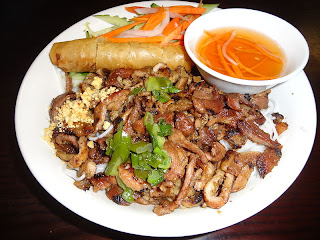Vietnamese food, Vietnamese cuisine
Vietnamese cuisine encompasses the foods and beverages of Vietnam. Regular ingredients include fish sauce, shrimp paste, soy sauce, rice, fresh herbs, fruits and vegetables. Vietnamese recipes utilize lemongrass, mint, Vietnamese mint, long coriander and Thai basil leaves. Traditional Vietnamese cooking is greatly admired for its fresh ingredients, minimal use of oil, and reliance on herbs and vegetables. Vietnamese food is often ranked as one of the healthiest cuisines in the world. The most common meats used in Vietnamese cuisine are fish, chicken, pork, beef, and various kinds of seafood. The Vietnamese also have a strong vegetarian tradition influenced by Buddhist values.
Regional variations: The mainstream culinary traditions in all three regions of Vietnam share some fundamental features:
- Freshness of food: Most meats are only briefly cooked to preserve their original textures and colors. Vegetables are eaten fresh; if they are cooked, they are boiled or only briefly stir-fried.
- Presence of herbs and vegetables: Herbs and vegetables are essential to many Vietnamese dishes and are often abundantly used.
- Broths or soup-based dishes are common in all three regions
- Presentation: The condiments that accompany Vietnamese meals are usually colorful and arranged in eye-pleasing manners.
While sharing some key features, Vietnamese culinary tradition differs from region to region.
In northern Vietnam, a colder climate limits the production and availability of spices. As a result, the foods here are often less spicy than those in other regions. Black pepper is used in place of chiles as the most popular ingredient to produce spicy flavors. In general, Northern Vietnamese cuisine is not bold in any particular flavor—sweet, salty, spicy, bitter, or sour. Most northern Vietnamese foods feature light and balanced flavors that result from subtle combinations of many different flavoring ingredients. The use of meats such as pork, beef, and chicken were relatively limited in the past. Freshwater fish, crustaceans, and mollusks—such as prawns, squids, shrimps, crabs, clams, mussels—are widely used. Many notable dishes of northern Vietnam are crab-centered (e.g., bún riêu). Fish sauce, soy sauce, prawn sauce, and limes are among the main flavoring ingredients. Being the cradle of Vietnamese civilization, northern Vietnam produces many signature dishes of Vietnam, such as phở, bún riêu, and bánh cuốn, which were carried to central and southern Vietnam through the road of Vietnamese migration.
The abundance of spices produced by central Vietnam’s mountainous terrain makes this region’s cuisine notable for its spicy food, which sets it apart from the two other regions of Vietnam where foods are mostly non-spicy. Once the capital of the last dynasty of Vietnam, Hue’s culinary tradition features highly decorative and colorful food, reflecting the influence of ancient Vietnamese royal cuisine. The region’s cuisine is also notable for its sophisticated meals constituted by many complex dishes served in small portions. Chili peppers and shrimp sauces are among the frequently used ingredients. Some Vietnamese signature dishes produced in central Vietnam are bún bò Huế and bánh xèo.
The warm weather and fertile soil of southern Vietnam create an ideal condition for growing a wide variety of fruits, vegetables, and livestock. As a result, foods in southern Vietnam are often vibrant and flavorful with liberal uses of garlic, shallots, and fresh herbs. Sugar is added to food more than in the other regions. The preference for sweetness in southern Vietnam can also be seen through the widespread use of coconut milk in southern Vietnamese cuisine. Vast shorelines make seafood a natural staple for people in this region. Southern Vietnam has also been the region where influences from foreign cuisines (Chinese, Indian, French, Thai, etc.) are most prominent.

No comments:
Post a Comment